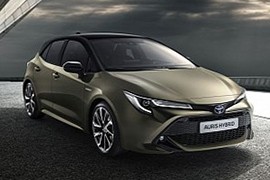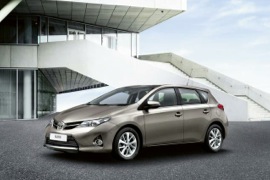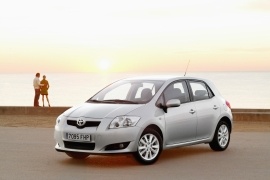TOYOTA Auris 5 Doors Models/Series Timeline, Specifications & Photos
First production year: 2006
Engines: Gasoline, Diesel, Hybrid, Hybrid gasoline
Body style: Hatchback
Auris was born as the hatchback version of the Corolla, and by 2018, it had already reached its third generation, which was unveiled at the Geneva Motor Show.
Toyota pushed its electrification program further and introduced the third generation of the Auris with a wider choice of electrified models. It didn't rely only on fuel efficiency but also on performance. Thus, customers who were reluctant to switch to hybrids had something that attracted them more. In addition, the conventional engine-only versions were still kept under production, thus helping the carmaker to sell them for a lower price than the hybrid versions.
The Auris was clearly designed to address the younger generation. It featured a front fascia with narrow headlights and a shape that resembled a pair of fangs. Moreover, the lower bumper featured a trapezoidal-shaped grille that covered most of the lower apron. Thus, the car's look was very aggressive. From its profile, the hatchback's beltline was raised on the rear doors and connected to the raked-forward C-pillars. In addition, the two-tone bodywork, with a contrasting greenhouse available as an option, amplified the car's sporty look.
Inside, Toyota packed the Auris with its latest technologies. It started with introducing a digital instrument cluster and continued with the touchscreen infotainment system placed atop the center stack. The sport bucket seats at the front were also comfortable, but they were high-mounted, which helped the rear passengers' legroom. At the back, the split-folding bench allowed three adults to sit there, but not for long trips.
Under the hood, besides the three internal-combustion engine-only versions, Toyota added a choice of two hybrid drivetrains. One was carried over from the Prius and provided a very good fuel efficiency, while the other was punchier, with an under eight-seconds time for the 0-62 mph (0-100 kph) run.
The Toyota Auris, a competitor in the compact market, received a redesign in 2015 that affected the entire range, including the popular 5-door version.
To meet the 2015 Euro 6b emission requirements, the Japanese automaker had to upgrade every model in its lineup. While that was a highly challenging assignment for other automakers, things moved more smoothly for Toyota because of its significant environmental protection research. The automaker also updated the vehicle's appearance along with the improved engine.
The car's new front bumper featured a wider lower grille extended from side to side in the lower part of the bumper. That improved the cooling area, helping the main narrow grille that was redesigned. In addition, the automaker installed LED Daytime Running Lights inside the new, modified headlamps. Significant alterations were also made to the automobile's rear, including new LED taillights with larger reversing lights. Finally, at the back, a pair of horizontal reflector lamps flanked a thin, chromed line placed on the bottom of the rear bumper.
The dashboard of the 2015 Auris has been updated. In the instrument cluster, the automaker consequently added a new color TFT display between the tachometer and speedometer. In addition, the infotainment system was improved, and the HVAC system controls got a new button layout on the center stack. Last but not least, softer materials were used to raise the materials' quality. The split-folding rear bench expanded the trunk volume from a mediocre 360 liters (12.7 cu-ft) to an excellent 1,199 liters (42.3 cu-ft).
The 2015 Auris received a choice of new engines, which started with a 1.2-liter turbocharged gasoline unit. A 1.6-liter oil burner replaced the former 2.0-liter turbo-diesel. As expected, Toyota kept the hybrid version on the list.
The 2013 Toyota Auris is the second generation of the nameplate. The car was previously known as the Toyota Corolla Hatchback. After that, the Japanese carmaker decided to change the name for the hatchback and leave the Corolla only for the sedan version and for some countries. The Auris was criticized for having a bold look in the C-Segment, where all the other manufacturers had tried their imagination.
The 2013 model has a sharper look, with angled headlights and an aggressive design with air scoops on the sides of the front bumper like those usually used for cooling brakes, and a central larger one. The grille is also designed into a V-shape to complete the fascia. The car is not as sporty as it looks, but at least it looks better. Depending on trim level, the Auris was available with steel or light-alloy wheels.
Under the hood there was a range of engines from 1.2-liter to 2.0-liter ones, both gasoline and diesel. The smallest unit was turbocharged and offered 115 hp, while the most powerful unit was the 1.8 with 144 hp. The diesel units were turbocharged with 1.6-liter and 2.0-liter displacement and offered 90 hp and 124 hp, respectively.
Inside the vehicle, there is room for five with a flat floor for the rear passengers. The infotainment system has a USB port for music input or charging the phone.
The world financial crisis was still causing damage to the market, but Toyota couldn't wait for that to end in order to launch new products, so in 2010, the automaker came with a refreshed version of the Auris.
Toyota introduced the Auris as a hatchback version of the Corolla in 2007, and customers were not exactly happy with that change. Still, the vehicle was adequate and proved that a well-built vehicle would sell well even if its name was new. Meanwhile, the Japanese brand sold the Auris as a three- or five-door hatchback. While the former version was mostly created to compete against sportier-looking, youth-oriented vehicles, the latter was mainly for those with families. The recipe worked better for this one.
The refreshed version of the Auris came with a new front fascia that sported wider front and rear bumpers. In addition, the headlights received LED daytime running lights and a downward V-shaped grille. The profile, on the other hand, didn't change. For specific versions, the carmaker added a roof spoiler on the upper side of the tailgate. All these changes led to a better aerodynamic coefficient that dropped from 0.29 to 0.273, resulting in lower emissions.
Inside, the car went got some significant upgrades with the introduction of new, softer materials for the dashboard. The steering wheel was enriched with buttons for phone use via Bluetooth connectivity. Furthermore, the center console was slightly raised so the driver could reach the stick easier than on the pre-facelifted version.
Underneath the hood, Toyota installed new Euro 5 engines, both gasoline and turbo-diesel, and a hybrid powertrain.
In 2006, Toyota changed its compact segment lineup and renamed the Corolla hatchback as Auris, while the sedan version kept its original name.
It was a bold move for the Japanese carmaker, which adopted the "-is" to match the same final letters as the other core models such as Yaris or Avensis. Regardless of the car's name, the compact segment hatchback aimed directly at the Volkswagen Golf, Ford Focus, and Renault Megane.
With the new model, Toyota introduced a fresh, young design language. It featured a front fascia with horizontal lines, which made the car looks wider, sportier. The lower bumper sported a wide center grille with two side scoops on the outer sides. Its angular-shaped headlights resembled those installed on the Avensis and the Yaris but still had their personality. From its sides, the slightly curved body panels gave the car a minimalist design look, but not bland.
Toyota officials stated that the car was designed from inside out, and it looked like that. The interior featured a unique tall center console that was connected to the center stack through a sloped, ascending bridge where the gear-stick (or the gear selector) took center stage. For the multimedia system, the carmaker offered a few choices depending on the trim level named Terra (Earth) for the base level, Luna (Moon) as the mid-level, and Sol (Sun) for the highest level. A navigation system was on the options list. Toyota's designers said that an airliner cockpit layout inspired them. The front bucket seats were made more on the comfort side, while the rear 60/40 split-folding seatback allowed the user to expand the trunk.
Under the hood, the carmaker installed a choice of seven engines, either gasoline or turbo-diesel. Some of them were available with an automatic gearbox.




